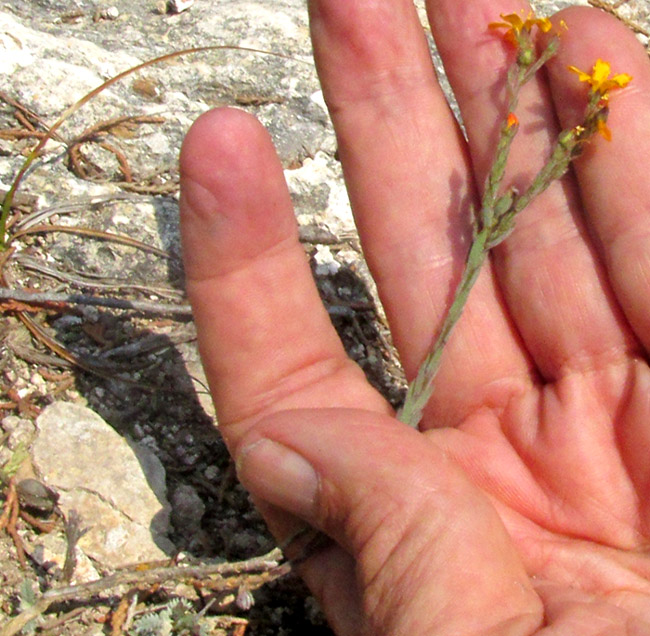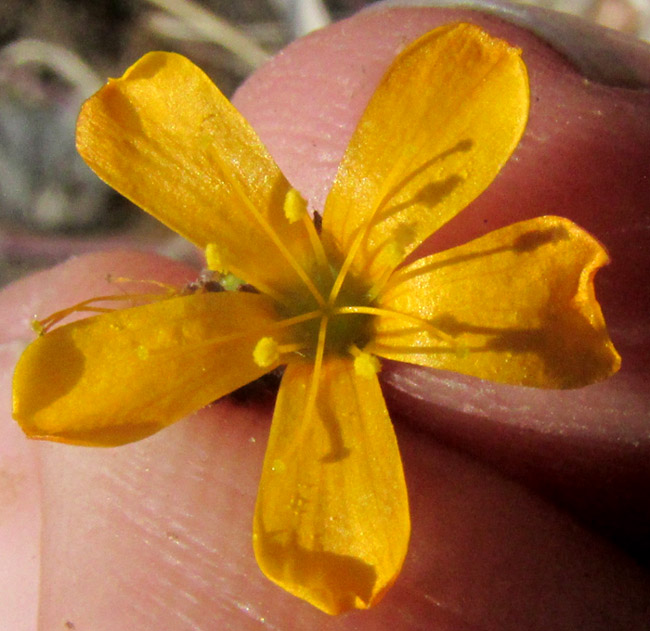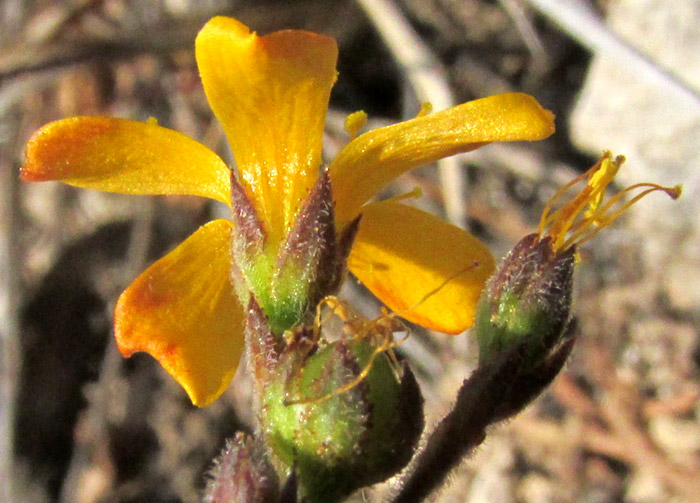Excerpts from Jim Conrad's
Naturalist Newsletter
entry from field notes dated May 5, 2023, taken about 150m uphill on NE-facing slope, above intersection of road from Hwy 120 to San Joaquín, with road to El Doctor; juniper and pine forest on limestone bedrock; elevation ±2425m (7950 ft); Eastern Sierra Madre mountains of east-central Querétaro state, MÉXICO, (N20.88°, W99.62°)
"WILD FLAX"

At the rocky base of a high limestone wall, the above wildflower was so well camouflaged, so small, and so agitated by the wind that for a picture my hand was needed to highlight and stabilize it. A closer look revealed an interesting identification feature.

At the right, notice that flowers are arranged in a panicle, which is an inflorescence with branches that branch, and maybe branch again and again. Further, this inflorescence's primary branches behave as cymes, which are arrangements of blossoms having a central stem bearing one terminal flower that develops first -- in the picture, the older flower in the Y-s crotch -- with other flowers developing on stems arising beside the first flower's base. Most plant families could never do this.

Until now, with my blurry vision, the dazzling sunlight and wind shaking everything, our plant struck me as just another LYC -- "little yellow-flowered composite" -- a composite being a member of the Composite/Aster/Sunflower Family, the largest of all plant families. However, the above photo shows that not only is this a single flower instead of several in a composite head, but also it displays a surprising feature: Between each of the five stamens with their yellow, pollen-laden anthers, there's a long, slender style arcing above a yellow petal. Which families can make five styles atop their ovaries?

From the side, the flowers didn't display anything extraordinary, though the short hairiness of the sepals and pedicels was noteworthy. At the above picture's bottom, the corolla has fallen off, stamens and styles have withered, and the ovary has enlarged into a spherical immature fruit.

All the plant's vegetative parts were hairy, as shown at the right. Leaves were small, one leaf per stem node, and the leaves are held close to the stem.
It took awhile to figure out this plant's family. Its blossoms were reminiscent of the St. John's Wort Family, the Hypericaceae, but that family's leaves arise in opposite pairs, not alternating on the stem like our plant. Also, usually its flowers bear more stamens.
Eventually, largely because of the plant's slender form and small leaves, the Flax Family, the Linaceae, was remembered, flowering fields of flax having been admired in Europe. The Flax Family is a small one embracing only about 200 species, mostly in the world's temperate and subtropical regions. The cultivated Flax plant is the family's only well known species. Flax's tough stem fibers are used to produce the textile linen, and linseed oil is crushed from the small seeds.
In this part of upland central Mexico known as the Bajío Region, only one genus of the Flax Family's ten or so genera is represented, and that's the Flax Genus itself, Linum. In this area we have about nine flax species, of which eight display yellowish flowers, and only one -- Europe's cultivated Flax, which has become invasive here -- with blue flowers. Informally, all species of the genus Linum, except the cultivated Flax, can be called "Wild Flaxes."
In the Bajío Region, if you have a yellow-flowered flax plant with styles separated to their bases, the plant grows in dry, limestone-derived soils, not volcanic ones, and petals are orangish-yellow, not pure or pale yellow, you have LINUM SCABRELLUM, which has no particular English or Spanish name used just for it, so it's just one of several "wild flaxes."
No personal name is known because Linum scabrellum is an obscure little plant endemic just to a few upland Mexican states, where they appear in the Eastern Sierra Madre mountain chain from Tamaulipas in the north to Oaxaca in the south. That distribution is represented on the GBIF Linum scabrellum occurrences map. Within that narrow distribution, sometimes it's commonly found in pastures, dry scrub and pine forests.
Despite Linum scabrellum lacking its own name, flaxes in general -- the genus Linum -- are used in Mexican traditional medicine, as reported by Ivonne Alejandre-García and others in their 2015 study entitled "Cytotoxic Activity and Chemical Composition of the Root Extract from the Mexican Species Linum scabrellum: Mechanism of Action of the Active Compound 6-Methoxypodophyllotoxin." They say that flaxes are used to treat respiratory infections, snake bites, malaria, leishmaniasis, gastrointestinal affections, inflammation, and cystitis as well as other conditions.
Alejandre-García and her team found that compounds occurring both in the stems and roots of our Linum scabrellum are toxic to the cancerous cells of "... four selected human carcinomas and ... a normal fibroblast cell line."
Our little flax may keep a low profile, but it's powerful stuff if you know how to use it.